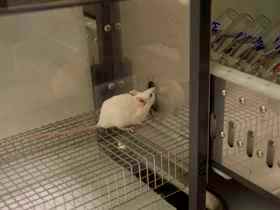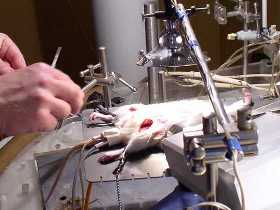Studies with experimental animals are performed at the Laboratory under control of ACUC of the Pavlov Institute of Physiology.
Experimental animals:
- Rats, Sprague-Dawley and Wistar (Pavlov Institute, Koltushi);
- Mice, C57Bl/6yJ, 129P3/J (Jackson Laboratory, ME), C57BL/6J-Tas1r3tm1Rfm (Monell Chemical Senses Center, PA);
- Guinea pigs;
- Mongrel dogs.
Investigation of the stomach physiology - secretion, motility, blood circulation
-
A method of continuous simultaneous quantification of gastric secretions of acid and bicarbonates based on pH and PCO2 measurements in the stomach perfusate combined with with spectrophotometric measurement of pepsinogen secertion in anesthetized rats or conscious animals with chronic gastric fistula.
-
A Method of assessment of gastric acid and pepsinogen secretions in conscious dogs equipped with a fistula in the Pavlov gastric pouch or gastric pouch according to Heidenhain.
-
An estimation of blood flow in the submucosal layer of the stomach or duodenum of anesthetized rats using laser Doppler flowmetry.
-
An Assessment of microcirculation (diameter of arterioles and venules, qualitative and quantitative parameters of leukocytes (rolling, adhesion, migration to tissue), vascular permeability ( extravasation of fluorescently-labeled albumin) in the submucosal layer of the stomach using an intravital video microscopy.
-
A method of estimation of gastric tone by a volume -pressure ratio in anesthetized rats
Studies of feeding behavior, evaluation of the effect of chemosensory factors, taste, smell, somatosensory irritation, on food preference
-
Evaluation of food preference / rejection by using the test of voluntary choice ("The test with two bottles") in mice and rats.
-
Evaluation chemosensory (taste) preference of test solution in a brief access paradigm using automated multichannel gustometer Davis MS-160 (DiLog Instruments, Tallahassee, FL, US) in mice and rats.
Models of experimental ischemia (global cerebral ischemia, focal cerebral ischemia as a model of stroke, myocardial ischemia-reperfusion) and an assessment of induced disorders
-
Assessement of neuroprotective properties of substances by using experimental models of stroke (focal cerebral ischemia) and a model of global cerebral ischemia.
-
A study on the cardioprotective effects using experimental model of the acute myocardial infarction and the ischemia-reperfusion model of infarction in a chronic experiment
Behavioral and neurological testing, modeling of depression
-
Neurological assessment of sensorimotor disorders during brain lesions using the neurological scale or the open field test.
-
Evaluation of cognitive functions, learning and memory , using the water maze test of Morris and the open field test.
-
Assessment of anxiety and depression using the elevated plus maze test, open field test, food preferences tests.
-
Modeling of depression using the Porsolt test, or surgical olfactory bulbectomy
Biochemical analyses of blood plasma and tissue homogenates
|


  |



